Okay, real talk—how many times have you sworn you were eating “barely anything” but still not losing weight? Or maybe you’re trying to bulk up and eating like it’s your job, but the scale won’t budge? Here’s the thing: we’ve all been there, confused and frustrated about metabolism and calorie counting. And honestly? It’s not your fault. The whole metabolism game is way more complex than most people realize.
So let’s clear this up once and for all. Your resting metabolic rate (RMR) is basically the secret sauce to understanding why your body does what it does, and once you get it, everything else starts making sense.
- What's Actually Going On With Your Metabolism?
- The Calculation Challenge: Why Those Online Calculators Are Kinda Lying to You
- The Gold Standard vs. Playing the Guessing Game
- But Here's the Real Problem…
- Real People, Real Problems: Why the Math Gets Messy
- Case Study 1: Sarah – The “Average” Weight-Loss Client
- Case Study 2: Marcus – The Muscular Athlete
- Case Study 3: Linda – The Chronic Dieter With a “Slow” Metabolism
- The Game-Changer: It's All About Your Organs
- The Tissue-Specific Breakdown
- What Actually Affects Your RMR? (The Stuff You Can and Can't Control)
- How to Actually Boost Your RMR (The Stuff That Works)
- The Weight Loss Curveball: Metabolic Adaptation
- Your Game Plan: Making This Work in Real Life
- When Those Calculators Just Won't Cut It
- Your Step-by-Step RMR Strategy
- The Bottom Line
What’s Actually Going On With Your Metabolism?
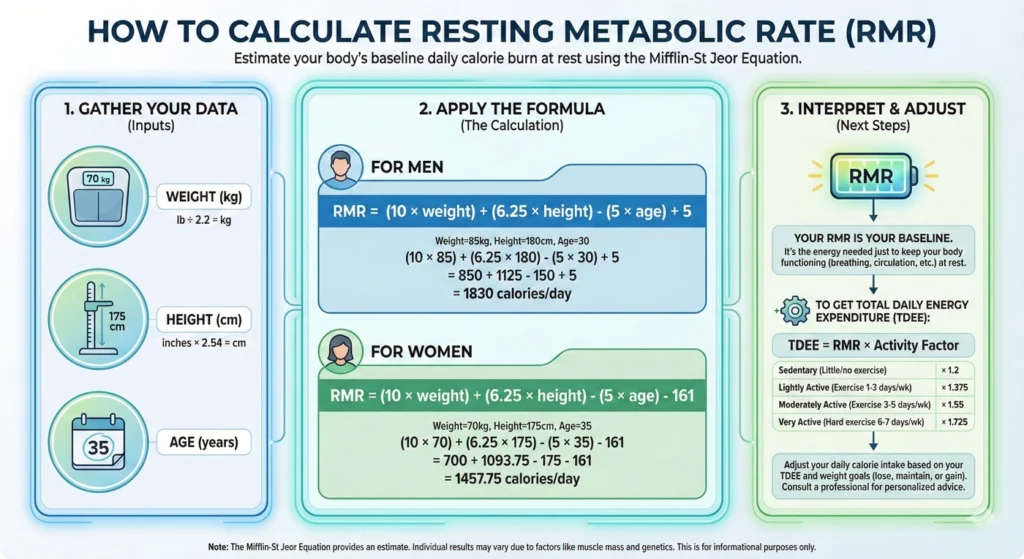
First things first—what is metabolism, anyway? In the simplest terms, it’s how your body converts the food and drinks you consume into energy. Pretty straightforward, right? But here’s where it gets interesting.
Your body burns calories throughout the day in a few different ways, and the total amount is called your Total Daily Energy Expenditure (TDEE). Think of TDEE as your daily calorie-burning budget, made up of three main chunks:
- RMR – The calories you burn just existing (we’ll dive deep into this)
- TEF (Thermic Effect of Food) – The energy it takes to digest your food
- TEPA/NEAT – The calories you burn through intentional exercise and just moving around in general
Now, you’ve probably heard people throw around terms like BMR and RMR interchangeably, but there’s actually a difference—and knowing it can save you from some serious confusion.
BMR vs. RMR: What’s the Deal?
BMR (Basal Metabolic Rate) is like the absolute rock-bottom minimum calories your body needs to keep you alive. We’re talking breathing, keeping your heart pumping, maintaining your organs—the essentials. To measure your true BMR, you’d need to be in super strict conditions: completely at rest, fasted for 12-14 hours, in a temperature-controlled room, right after waking up. It’s basically impossible to replicate outside a lab.
Resting metabolic rate, on the other hand, is measured under more realistic conditions. Maybe you had a light breakfast, or you’ve been resting for a bit but not under those incredibly strict rules. And here’s the kicker: your RMR is usually about 10% higher than your BMR.
So what’s the takeaway? When you’re trying to figure out what is resting metabolic rate and how many calories you need daily, RMR is the number you actually want to focus on. It’s way more practical and relevant to real life.
The Calculation Challenge: Why Those Online Calculators Are Kinda Lying to You

Alright, buckle up because this is where things get wild. You know those “resting metabolic rate calculator” tools all over the internet? The ones that ask for your age, weight, and height, then spit out a magic number? Yeah… they’re not exactly reliable.
The Gold Standard vs. Playing the Guessing Game
The most accurate way to measure your RMR is through something called Indirect Calorimetry (IC). This method measures your oxygen consumption and carbon dioxide production to figure out exactly how many calories you’re burning. It’s super precise but also expensive and requires special equipment and controlled conditions (think: fasting, lying completely still).
Since most of us don’t have access to a metabolic lab, we rely on prediction equations. Let me break down the most popular ones:
Harris-Benedict (H&B): This is the old-school formula that’s been around forever. Problem? It can be off by up to 36% in people in higher‑weight bodies. That’s huge!
Mifflin–St Jeor: This is the newer, more accurate option. Studies show it’s the closest to the gold standard (IC) for most people, especially people in higher‑weight bodies. If you’re going to use an online calculator, make sure it’s using this formula.
Cunningham/Katch-McArdle: These formulas use your fat-free mass (FFM) to predict RMR. They’re great if you actually know your body composition accurately, but most people don’t.
But Here’s the Real Problem…
Even the best equations—we’re talking Oxford/Henry, Cunningham, the works—are often only accurate within a 300-400 calorie range. And in some cases? The error can be as wide as 800 calories. Even the most precise equation (Ten-Haaf) only predicted 80.2% of participants to be within ±10% of the measured value, with others ranging from 40.7 to 63.7%. That’s like an entire meal!
Studies have demonstrated accuracy within 10% of true RMR (Mifflin St Jeor) to as high as 36% error inhigher-weight individuals (Harris-Benedict). The Mifflin-St Jeor equation is more likely than the other equations tested to estimate RMR to within 10% of that measured, but noteworthy errors and limitations exist when it is applied to individuals and possibly when it is generalized to certain age and ethnic groups.
Real People, Real Problems: Why the Math Gets Messy
To see how this plays out, meet three fictional-but-realistic people: Sarah, Marcus, and Linda.
Case Study 1: Sarah – The “Average” Weight-Loss Client
Profile:
- 30 years old
- 5’5″ (165 cm)
- 154 lbs (70 kg)
- Around 28% body fat
- Desk job, works out a few times per week
When we run her numbers through different equations:
- Harris-Benedict: ~1,475 kcal/day
- Mifflin–St Jeor: ~1,420 kcal/day
- Katch–McArdle (using lean mass): ~1,460 kcal/day
All three cluster around 1,400–1,500 calories. That’s pretty tight agreement.
If we then apply a moderate activity factor (around 1.35–1.4), her TDEE lands near 1,900–2,000 calories.
Aiming for 1,450–1,650 calories per day would put Sarah in a slow, steady deficit.
What this shows:
For someone like Sarah—average size, average composition, no extreme dieting history—standard equations can work well enough as a starting point.
Case Study 2: Marcus – The Muscular Athlete
Profile:
- 25 years old
- 5’11” (180 cm)
- 220 lbs (100 kg)
- About 12% body fat (~88 kg lean mass)
- Rugby player, trains hard and often
Now let’s run the math:
- Mifflin–St Jeor: ~2,005 kcal/day
- Katch–McArdle: ~2,270 kcal/day
Same person, same stats, very different answers. That’s a ~265 calorie difference per day at rest.
Now layer on his activity level—Marcus is “very active” (activity factor ≈ 1.7–1.8):
- Using 2,005 as his RMR → TDEE ≈ 3,400–3,500 kcal
- Using 2,270 as his RMR → TDEE ≈ 3,800–4,000 kcal
If Marcus trusts the lower estimate and eats 3,200 calories “to bulk,” he might think he’s in a surplus. In reality, he could be hovering around maintenance or even in a slight deficit, especially on heavy training days.
He’s tired, not gaining, and frustrated—because the math he relied on underestimates his true needs.
What this shows:
For highly muscular people, especially athletes, equations based only on weight, height, and age often undercalculate RMR. Lean-mass-based formulas or direct testing are a much better fit.
Case Study 3: Linda – The Chronic Dieter With a “Slow” Metabolism
Profile:
- 50 years old
- 5’3″ (160 cm)
- 187 lbs (85 kg)
- Long history of crash diets and weight cycling
On paper, using Mifflin–St Jeor, her predicted RMR is about:
- ~1,500 kcal/day
So a generic plan might put her at 1,300 calories for fat loss. That sounds modest, right?
But when her RMR is actually measured via indirect calorimetry, the result is:
- ~1,250 kcal/day
That’s about 250 calories lower than predicted—roughly a 17% drop below expectation.
If Linda eats 1,300 calories thinking she’s in a 200-calorie deficit, she’s really:
- Barely below maintenance
- Or effectively at maintenance once normal day-to-day fluctuations are considered
She feels like, “I’m eating so little and nothing is happening.” And she’s not imagining it—her metabolism really is running lower than what the equations predicted. That’s metabolic adaptation in action.
What this shows:
For people with long histories of aggressive dieting, the body may adapt by lowering RMR beyond what you’d predict from weight and body composition alone. Generic calculators don’t capture that.
The Game-Changer: It’s All About Your Organs
Here’s something most fitness influencers won’t tell you: your resting metabolic rate isn’t primarily determined by how much muscle you have. The real MVPs are your high metabolic rate organs—specifically your liver, brain, heart, and kidneys.
Get this: these four organs alone account for roughly 50% of your total RMR, but they make up less than 5% of your body mass. Mind-blowing, right?
The Tissue-Specific Breakdown
Let me blow your mind with the actual numbers:
- Visceral Organs (Brain, liver, heart, kidneys): Only 5-6% of total body weight, but responsible for 60-80% of RMR. The heart and kidneys have metabolic rates 15-40 times greater than resting skeletal muscle per unit of weight.
- Skeletal Muscle: About 40% of body weight in healthy adults, with a specific metabolic rate of ~13 kcal/kg/day. While relatively low per pound, its sheer mass makes it significant—and crucially, it’s the largest modifiable component of RMR.
- Adipose Tissue: Fat burns about 4.5 kcal/kg/day. It’s metabolically sluggish but not inert, and in people carrying extra weight, the sheer volume can contribute significantly to total RMR.
The size and metabolic activity of these organs vary massively between people, and that’s why those simple calculators that only look at height, weight, and age can’t accurately predict how to calculate resting metabolic rate for everyone. Your organs are doing their own thing, and formulas can’t account for that.
This also explains why athletes don’t just have higher RMRs from muscle mass alone. Intense training actually increases the size of your liver, heart, and kidneys—those metabolically expensive organs. Your body literally builds a bigger metabolic engine.
What Actually Affects Your RMR? (The Stuff You Can and Can’t Control)
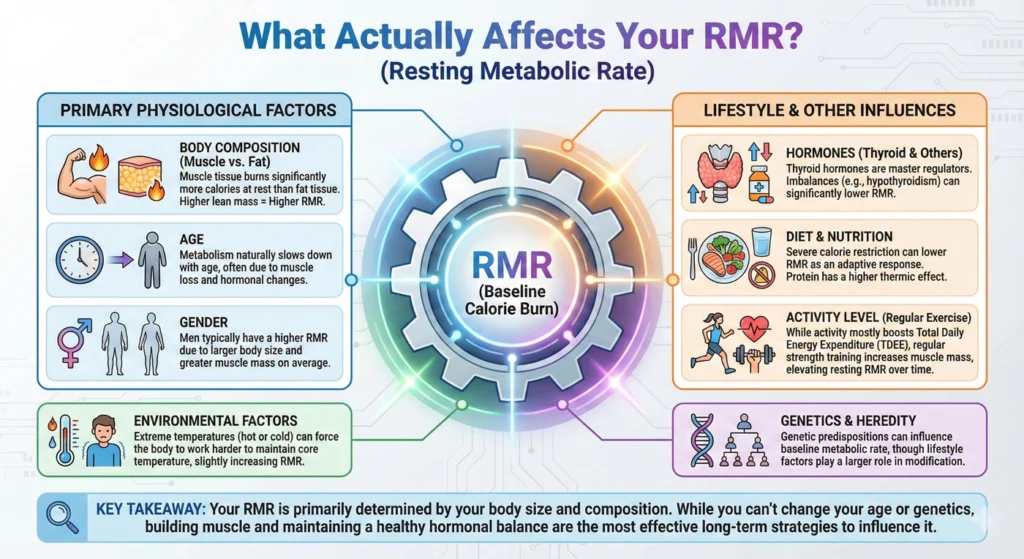
Let’s break down the factors that influence your metabolism into two camps: the things you’re stuck with and the things you can actually do something about.
The “You’re Stuck With It” Factors
Age: Sorry, but getting older does slow your metabolism. After your early 20s, RMR drops by about 2% per decade. And once you hit 60? That decline picks up speed, even if you maintain your body mass. Not fair, but it’s life.
Sex: On average, guys have higher RMRs than women because they typically have more lean muscle mass and overall larger bodies. When adjusted for Fat-Free Mass, sex differences in RMR largely disappear, reinforcing that it’s about tissue composition, not biological sex itself.
Genetics: Yep, some people won the genetic lottery. Certain genes (like the FTO gene) can influence your satiety signals and RMR by up to 160 calories per day. However, genetic variations in basal mitochondrial efficiency likely account for less than 10% of the variance in RMR between individuals of identical body composition. If you’ve got a friend who eats everything and never gains weight, this might be why—and you have permission to be jealous.
Body Size: Generally speaking, bigger people have higher RMRs because there’s simply more of them to maintain. More mass = more energy needed to keep things running.
The “You Can Actually Change This” Factors
Lean Body Mass/Muscle Mass: This is THE big one you can control. Building muscle increases your RMR because muscle tissue is metabolically expensive to maintain. Even gaining just 2-4 pounds of muscle can boost your metabolism by 7-8%. Not too shabby!
Sleep Quality: Sleep restriction significantly impairs metabolic rate, with studies showing sleep-restricted groups exhibiting a decrease in morning RMR of approximately 2.6% to 5%. While this percentage appears small, its cumulative effect over months of chronic sleep deprivation can be substantial.
Environmental Factors: Being in extreme cold or heat forces your body to work harder (shivering or sweating), which temporarily bumps up your BMR. Not exactly practical for daily life, but it’s interesting.
Stimulants: Your morning coffee is actually helping! Caffeine and capsaicin (the compound that makes peppers spicy) can temporarily increase your RMR by 4-5%, which translates to about 15-25 extra calories burned per day. It’s not massive, but hey, every little bit counts.
Hormonal Status: Your thyroid hormones (T3 and T4) are the master regulators. Hyperthyroidism can elevate RMR by 20-100%, while hypothyroidism can suppress it significantly. The good news? Normalizing thyroid levels in hypothyroid patients restores RMR to baseline.
How to Actually Boost Your RMR (The Stuff That Works)
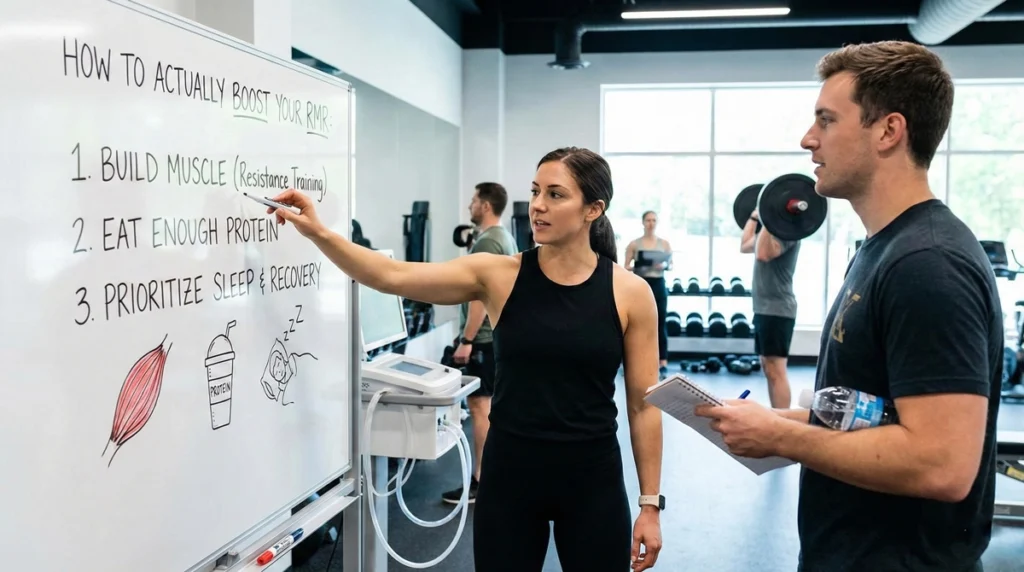
Alright, enough theory—let’s talk practical strategies. I’m going to walk you through the most effective ways to optimize your resting metabolic rate, and trust me, it’s not about doing some weird detox tea cleanse.
Exercise: Build That Muscle!
Resistance Training is Non-Negotiable: If you want to increase your RMR, you need to lift weights or do some form of resistance training. Period. Building lean muscle mass is the single most effective way to boost your metabolism long-term.
Here’s what actually happens when you build muscle: Each pound of muscle burns about 6-7 calories per day at rest (not the “50 calories” myth you see floating around). But here’s the cool part—trained muscle has much higher protein turnover, meaning it’s constantly breaking down and rebuilding. This process is metabolically expensive.
And here’s something cool: athletes don’t just have higher RMRs because they have more muscle. Intense training actually causes a proportional increase in high metabolic rate organ mass—especially the heart, liver, and kidneys. Your body literally adapts to become more metabolically active. How awesome is that?
HIIT for the Win: High-Intensity Interval Training creates something called Excess Post-Exercise Oxygen Consumption (EPOC), which is a fancy way of saying your metabolism stays elevated after your workout. EPOC is greater after intense or longer workouts, accounting for about 6-15% of the total oxygen cost of the exercise. It’s like getting bonus calorie burn while you’re on the couch afterward.
Nutrition: Feed Your Metabolism Right
Protein is Your Best Friend: Protein requires way more energy to digest than carbs or fat. We’re talking 15-30% of its calories get burned just processing it, compared to 5-10% for carbs and basically 0-3% for fat. Plus, eating enough protein helps you maintain and build that all-important lean muscle mass. Win-win.
Don’t Go Too Low: I know it’s tempting when you want fast results, but severely restricting calories (below 1,200 for women or 1,600 for men) can backfire big time. Your body goes into conservation mode and can suppress your RMR by up to 20% through a process called Metabolic Adaptation. You’ll lose muscle mass, mess with your hormones, and actually make it harder to lose weight. Not worth it.
Your Gut Matters: Your microbiome (the bacteria in your digestive system) plays a bigger role in metabolism than most people realize. Keep your gut happy with diverse, colorful fruits and vegetables, and throw in some fermented foods like kimchi or sauerkraut. Your metabolism will thank you.
Lifestyle: The Foundation Nobody Talks About
Sleep Like Your Metabolism Depends On It: Because it does! Aim for 7-9 hours of quality sleep every night. When you’re sleep-deprived, your hormones go haywire, increasing your risk of obesity and diabetes. I know life gets intense, but prioritize sleep—it’s not lazy, it’s essential.
Stress is Literally Killing Your Metabolism: Chronic stress releases hormones called glucocorticoids, which mess with your metabolism and lead to weight gain (especially around your belly). Find what works for you—meditation, exercise, therapy, walking your dog—and make it a non-negotiable part of your routine.
Watch Out for Chemicals: This one sounds weird, but endocrine-disrupting chemicals (EDCs) in plastics, pesticides, and some cleaning products can seriously mess with your hormonal balance and metabolism. Switch to glass containers when you can, go organic where it matters most, and be mindful of what you’re exposing your body to.
The Weight Loss Curveball: Metabolic Adaptation
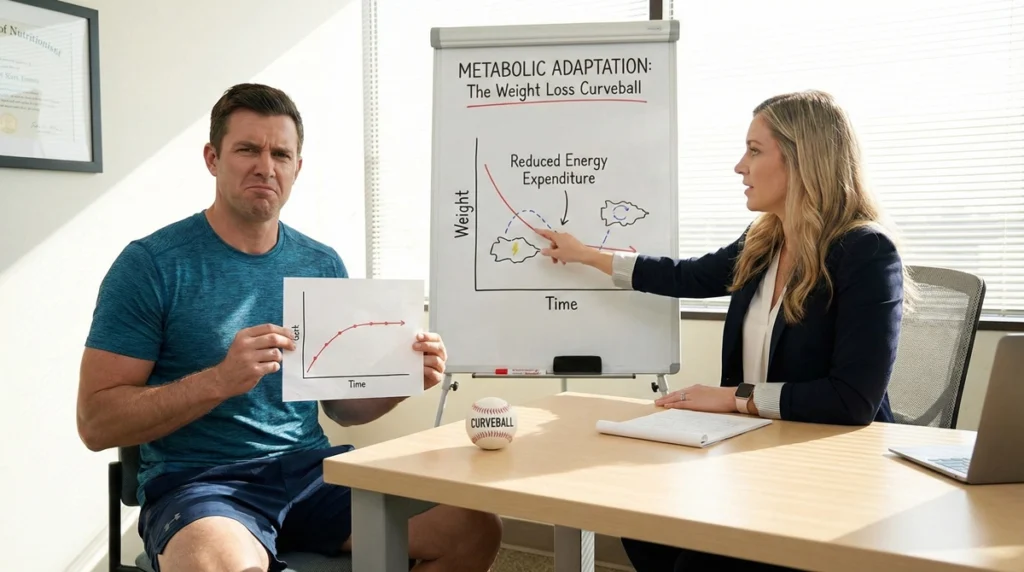
Let me blow your mind with something that happens during weight loss that nobody warned you about.
When you’re in a calorie deficit and losing weight, your RMR naturally decreases a bit—that makes sense because there’s less of you to maintain. But sometimes, your RMR drops more than it should based on the weight you’ve lost. That disproportionate decrease is called Metabolic Adaptation (MA), and it’s why weight loss plateaus are so frustrating.
The Biggest Loser Reality Check
Want to see how extreme this gets? Researchers followed contestants from “The Biggest Loser” and found their RMRs dropped by an average of 610 calories per day after massive weight loss. Here’s the kicker: about 400 calories of that drop couldn’t be explained by their weight loss alone. Their bodies literally became hyper-efficient.
Six years later? Most had regained significant weight, but their metabolisms were still suppressed. A formerly 300-pound person who now weighs 200 pounds needs to eat 10-15% fewer calories than someone who was naturally 200 pounds their whole life just to maintain the same weight.
This isn’t willpower—it’s biology defending against what it perceives as starvation.
Your Game Plan: Making This Work in Real Life
Here’s the deal: about half of this “extra” metabolic slowdown comes from losing high metabolic rate organ mass, particularly your liver and kidneys. They literally get smaller when you lose weight.
So what’s the solution?
The key is preserving your Fat-Free Mass (FFM)—basically, keeping as much muscle as possible while you lose fat. Studies show that if you successfully preserve FFM during weight loss, your RMR per kilogram of FFM might even increase slightly. That’s a good thing!
How do you preserve muscle during weight loss?
- Keep lifting weights (resistance training is crucial)
- Eat enough protein (aim for 0.7-1g per pound of body weight)
- Don’t cut calories too drastically
- Be patient with the process
- Consider diet breaks: Intermittent periods (e.g., 2 weeks on, 2 weeks off) of maintenance eating have been shown to attenuate the drop in RMR by periodically restoring leptin levels.
When Those Calculators Just Won’t Cut It
Look, most people can start with the Mifflin-St Jeor equation and get close enough. But there are some red flags that mean you should consider getting professionally tested:
- You’ve been yo-yo dieting for years
- You’re way more muscular than average (hello, athletes)
- Your weight loss has completely stalled despite “doing everything right”
- You have thyroid issues or other metabolic conditions
- The online calculators give you wildly different numbers
Professional testing (called Indirect Calorimetry) typically runs $75-150, but RMR estimation errors would be eliminated by valid measurement of RMR with indirect calorimetry. Indirect calorimetry may be an important tool when, in the judgment of the clinician, the predictive methods fail an individual in a clinically relevant way.
Your Step-by-Step RMR Strategy
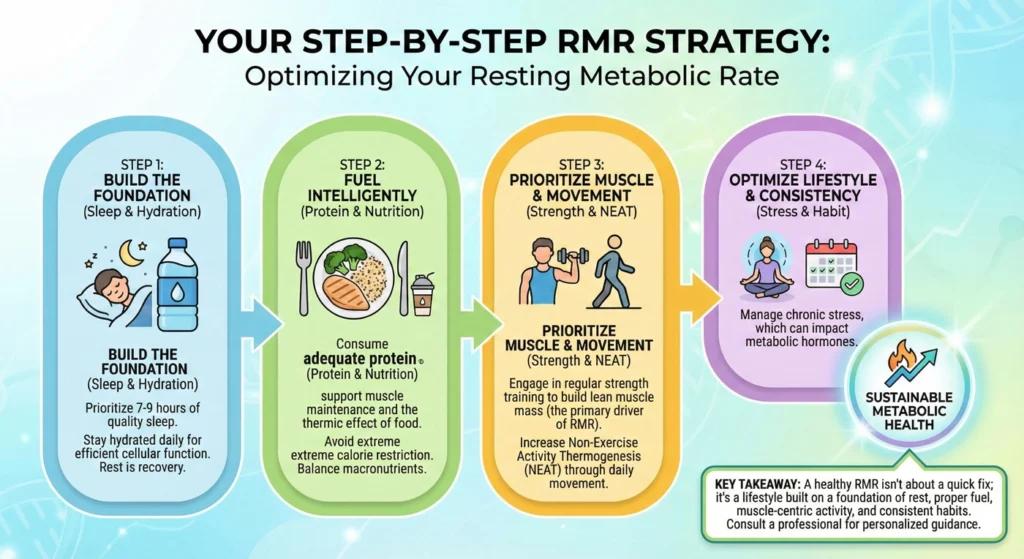
Phase 1: Get Your Baseline (Week 1)
- Use Mifflin-St Jeor if you’re “average”
- Use Katch-McArdle if you know your body fat % accurately
- Track your weight and energy levels for 1-2 weeks
Phase 2: Reality Check (Week 2-4)
- If you’re losing/gaining as expected: you’re golden
- If nothing’s happening: consider your equation is off by 200-400 calories
- If you’re chronically tired or losing weight too fast: eat more
Phase 3: Optimize (Month 2+)
- Adjust based on real-world results, not calculator predictions
- Consider professional testing if you’re still confused
- Remember: your RMR changes as your body changes
The Bottom Line
Your resting metabolic rate is the foundation of your energy balance. Understanding it—really understanding it—takes the mystery out of weight management and puts you back in the driver’s seat. No more wondering why things aren’t working. Just science, strategy, and results.
2024 research confirms that even the best equations only predict within acceptable ranges for populations, but no equation performs optimally at the individual level. Translation: there’s a significant chance your “calculated” RMR is off, but now you know how to work with it.
Focus on what you CAN control:
- Build muscle through consistent resistance training
- Eat enough protein to support that muscle
- Prioritize sleep (7-9 hours, no excuses)
- Manage your stress before it manages you
- Don’t crash diet—sustainable approaches actually work
- Take care of your gut with diverse, whole foods
And here’s my honest recommendation: if you’re serious about dialing in your nutrition and training, consider getting your RMR professionally tested with Indirect Calorimetry or at least work with a coach who understands the limitations of predictive equations. Having an actual personalized number beats guessing every single time.
Now get out there and put this knowledge to work! Your metabolism is waiting. 💪